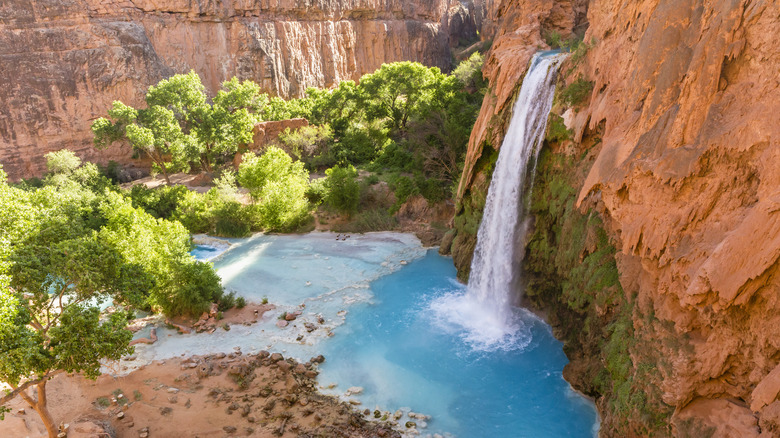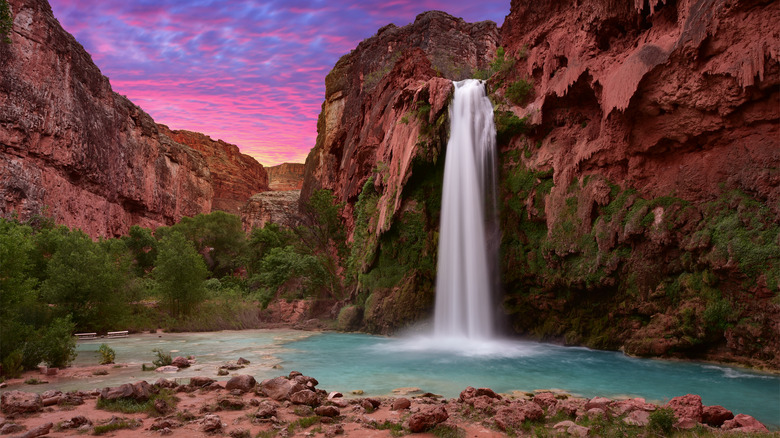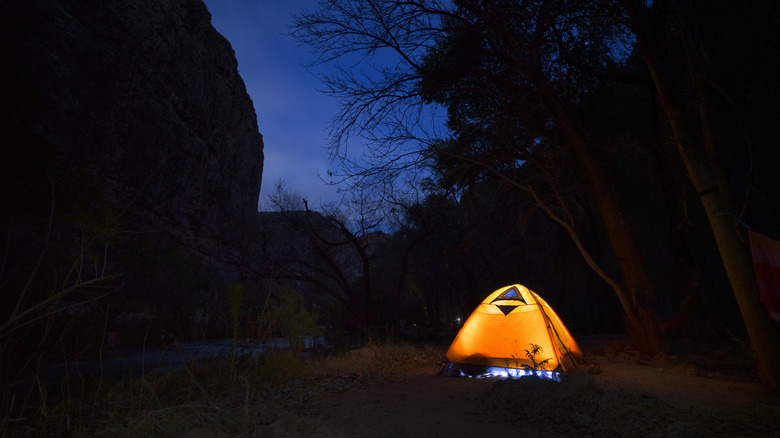One Of The US' Most Sought-Out Bucket List Hikes Is This Iconic Overnight Adventure
The Grand Canyon is one of the most iconic U.S. destinations, with millions of people visiting it every year from all around the world. Far fewer venture to the gorgeous turquoise falls hidden deep in the canyon. The staggeringly beautiful Havasu Falls still sees tens of thousands of visitors annually, but making your way down into the canyon is a lot harder than standing at the top and admiring the view.
Many hikes in U.S. national parks are only for experienced hikers, but the journey down to Havasu Falls is particularly challenging, and potentially deadly for the underprepared. In the heat of the Arizona summer sun, temperatures often soar into the triple digits, and the only water along the steep trail is what you're carrying on your back. This hike amounts to days of physically hard work, from tricky switchbacks to grueling heat. At one point, if you go all the way to Mooney Falls, you will have to descend a sheer cliff with only chains to cling onto while being sprayed by the falls.
Fortunately, if Havasu Falls is on your bucket list, you have plenty of time to prepare. While the Grand Canyon is a national park, the falls are actually on lands belonging to the Havasupai people, and you'll need to get a permit from them months in advance. As this is such a sought-after destination experience, permits sell out very quickly. Book as early as possible to ensure you get your shot at this incredible journey.
This is a hike you need to train for
While many plan this trip dreaming of 50-foot waterfalls, the entire journey is worth the adventure. You'll spend days with staggering views of the Grand Canyon in every direction. However, the journey to the falls can be long, hot, and intense, and potential climbers need to train to be fit enough for the challenge. Many hikers prepare by doing increasingly difficult hikes until they feel ready for Havasu Falls, typically wearing heavy backpacks to simulate the experience. You'll want some climbing practice, too. Some tour guides in the area recommend training at least six hours per week for three months before arriving at the canyon.
The return hike is harder because you're doing the same difficult hike but uphill and without the inspiration of the falls waiting at the end. If you don't pack enough supplies, including water, you may run out. If you're planning this as a solo hike, make sure to read over all the safety tips and take extra precautions. If you're desperate to do this hike but don't know if you can handle the return journey, there is an option to be picked up by a helicopter — but don't be tempted by the offers to have mules or horses carry your things, as there have been many reports of animal abuse on these routes, as reported by the SAVE Havasupai Horses organization. If you prepare, you'll be more than capable of handling your bags on the hike.
Sleeping at the bottom of the canyon
The refreshing, brilliant blue falls at the end make the journey to get there worth it — but visitors should prepare to be completely exhausted. Fortunately, sleeping in the canyon is always part of the experience. On your first day, you'll hike the 10 miles down to your campground and rest up for more in the morning. You'll have to carry everything you want for camping — from your tent to your dinner — on your back both ways, so this is the time to really pare back your equipment and consider leaving some items you'd typically bring for a quick camping retreat behind. Reservations for the campground are open from February 1, although you might be able to snag a presale date in January. Keep an eye on the Havasupai Campground Reservations site for those.
The campground itself is nestled between tall red cliffs that divide Havasu and Mooney Falls, so each morning, you can watch bright blue water pouring through the hot, dusty canyon. The competition for the best campsites can be fierce, so trying to snag one with a great view, a picnic table, or anywhere near the bathrooms can be hard on your first night. Some visitors have advised crossing the creek to the further half of the campground for a better shot at a good resting spot. Fortunately, it's easy enough to wake up early and move to your dream spot the next day if you must.


